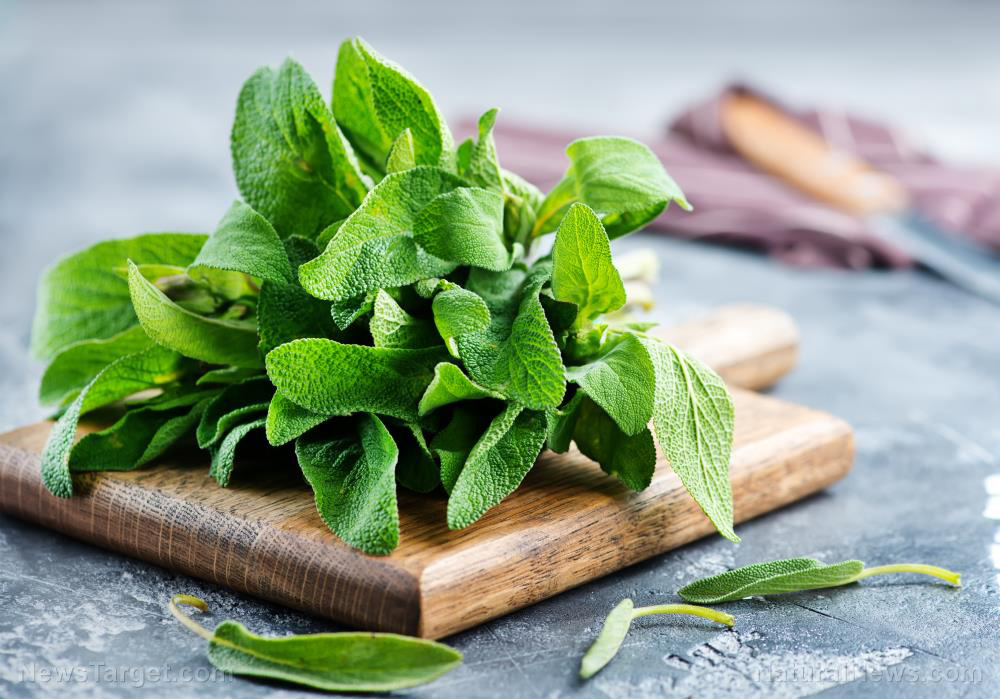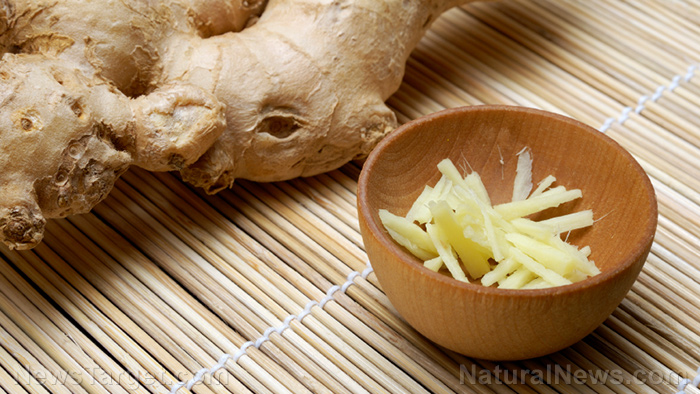
Advertisement
Sage is a flavorful herb that’s often used during Thanksgiving to season turkey and homemade stuffing.
The herb may be popular as a culinary seasoning for holiday recipes, but you also need to learn the medicinal uses of sage before SHTF. (h/t to TheSurvivalMom.com)
Sage: A versatile herb for your home garden
Sage belongs to the mint family. While there are many varieties, the one you’re probably most familiar with is the one used for cooking, Salvia officinalis.
Sage is very aromatic and using it gives your dishes an earthy, warm quality. The herb can be used fresh, dry, rubbed, and ground. (Related: 10 Ways to use comfrey, a powerful healing herb.)
While the modern use of sage usually involves savory dishes, sage has been valued for its health benefits for thousands of years.
The ancient Greeks and Chinese used varieties of sage to address different health issues. Native Americans used sage for meditation, protection and relaxation.
Common garden sage, the variety you often use for cooking, is also used for broader health purposes as recently as the late 1800s by early doctors like Physiomedicalists in the United States.
Traditionally, sage has been used to address minor discomforts like bloating and gas after eating a fatty meal to more serious health problems like typhoid fever and tuberculosis.
Sage health benefits
Sage is full of vitamins and minerals. One teaspoon (0.7 grams) of ground sage contains only two calories, 0.1 grams of fat and protein and 0.4 grams of carbs.
The same serving also contains:
- Vitamin K –10 percent of the reference daily intake (RDI)
- Iron – 1.1 percent of the RDI
- Vitamin B6 – 1.1 percent of the RDI
- Calcium – One percent of the RDI
- Manganese – One percent of the RDI
Sage also contains trace amounts of other nutrients like copper, magnesium, zinc and vitamins A, C and E. The herb also contains compounds like caffeic acid, chlorogenic acid, ellagic acid, rosmarinic acid and rutin, which are all linked to its beneficial effects.
And since you use sage sparingly as a spice, it only provides minuscule amounts of carbs, calories, fiber and protein.
Here are some of the many beneficial properties of sage:
- Antibacterial
- Antifungal
- Antioxidant
- Anti-inflammatory
- Antiseptic
- Astringent
- Expectorant
Antioxidants are molecules that help fortify your body’s defenses. They help neutralize potentially harmful free radicals associated with chronic health issues.
Sage contains over 160 distinct polyphenols — plant-based chemical compounds that act as antioxidants in the body.
Compounds in sage,, like caffeic acid, chlorogenic acid, ellagic acid, rosmarinic acid and rutin are linked to impressive health benefits like reduced cancer risk and improved brain function and memory.
According to a study, consuming one cup (240 ml) of sage tea twice daily significantly increased antioxidant defenses. The herbal tea also helped lower both total cholesterol and low-density lipoprotein (LDL) or bad cholesterol.
Additionally, consuming sage tea helped increase high-density lipoprotein (HDL) or good cholesterol.
Medicinal and prepping uses of sage when SHTF
Here are some of the medicinal and prepping uses of sage:
Digestive health
Experts think that constituents in sage can help assist the body with the breakdown of fats and proteins. This could explain why sage is often used to season meats.
Sage’s astringent, antispasmodic and carminative actions can help calm the digestive tract if you are bloated or suffering from diarrhea or gas.
Emotional well-being
Sage is an effective nervine. This means the herb helps settle and calm the nerves as it also strengthens your nervous system.
According to old sources, sage can be used to heal grief and uplift emotions.
Because of its influence on the nervous system, sage is often used to treat conditions like epilepsy and palsy. Sage is also used to strengthen the senses and sharpen the mind.
Since the aftermath of a natural disaster or emergency scenario may also cause grief or distress, sage may be a crucial part of your medicine cabinet.
Fevers
Sage can be used as an herbal remedy to support the nervous system during fevers. The herb is also used to treat fevers with signs of stress on the nervous system, including high fevers with delirium or convulsions or lower fevers with restlessness or muscle spasms.
To treat a fever, make a sage decoction. Steep one teaspoon of dried sage in hot water with a lid to preserve the oils. Tell the patient to deeply inhale the essential oils and drink the liquid.
Oral health
Traditionally, sage is used to promote oral health.
The herb can be used as a natural mouthwash for bleeding or receding gums. Sage is also used as a gargle for hoarseness, sore throat and swollen glands.
The antimicrobial properties of sage also help decrease dental plaque formation.
Sage leaf tea can be used as a gargle to promote oral health. When SHTF, you can even use the textured leaves as a makeshift toothbrush.
Thanks to its versatility, you can add sage to your herbal first aid kit for dental hygiene and throat health.
Respiratory health
Sage can help strengthen the lungs if you have a cough and bronchitis.
Traditionally, sage is used in smoking blends for asthmatics. However, research has found that the particles from a smoking blend may cause more problems in the long run than they relieve in the short term.
But using sage for herbal steam inhalation might still offer some relief.
If you opt to use steam inhalation, using sage essential oils is the fastest and easiest method. This technique is best for people with respiratory problems, but you can also use it if you have asthma as long as you are very careful.
Follow the steps below to use sage essential oil for steam inhalation:
- Boil water.
- Remove the boiling water from the heat and pour it into a bowl or basin.
- Place a few drops of sage essential oil in the water.
- Get a towel and put your head over the warm water. Drape the towel on top of your head and use it to cover the bowl to keep the steam in. Inhale the steam from the bowl
Sage can help relieve the coughing caused by a common cold. The herb can also help balance the runny nose and postnasal drip that often accompanies a cough.
Trauma recovery
You can also use sage for trauma recovery.
Traditional herbalists use sage when a traumatic injury could lead to fatal blood clots. The herb helps harmlessly break up clots and discourage strokes and thrombosis in patients.
Additionally, sage has astringent properties that make it useful for cleaning cuts and scrapes. Use sage to clean wounds by making applying sage tea to the affected area or using sage extract as a wash for wounds and bruises.
Considerations before using sage
According to studies, sage contains a thujone compound that can be toxic if it builds up in your body over time. Large doses of thujone can cause convulsions or even coma, so always follow the directions on the packaging that comes with any sage supplements that you purchase.
You should also follow the traditional wisdom regarding the length of time and serving size if you’re using homegrown sage.
Sage is safe when used at the levels normally found in cooking because the thujone compound mostly dissipates when the herb is cooked. Many herbalists consider sage safe when used for less than three weeks at a time.
Sage is a uterine stimulant so avoid it or use it with extreme caution if you are pregnant or suspect you are pregnant.
How to grow sage
You can grow sage at home to save a bit of money. Sage is easy to grow and it deserves a spot in a prepper’s edible landscape.
As a bonus, sage attracts pollinators and provides pest control.
Plant sage in full sun and in well-drained soil. Check nurseries and garden centers in spring for fresh sage.
Using sage
Aside from the common culinary uses of sage, the herb can be used to make soothing herbal tea and an extract.
Sage tea
To make one serving of sage tea, add one to two teaspoons of fresh or dried leaf to eight ounces of boiling water. Let the mixture steep for at least 10 minutes before drinking.
Sage extract
Take 15 to 30 drops of sage extract one to three times a day to reduce blood sugar levels or support memory and brain health.
Boost your digestive and oral health with sage, a flavorful and versatile medicinal herb.
Watch the video below for tips on how to start a herb garden.
This video is from the Resist2Survive channel on Brighteon.com.
More related stories:
Survival foraging: How to identify and use dandelion, a versatile weed.
Survival medicine: How to grow and use sunflowers as food and medicine.
Prepper medicine: How to use parsley, a versatile medicinal herb.
Sources include:
Advertisements







